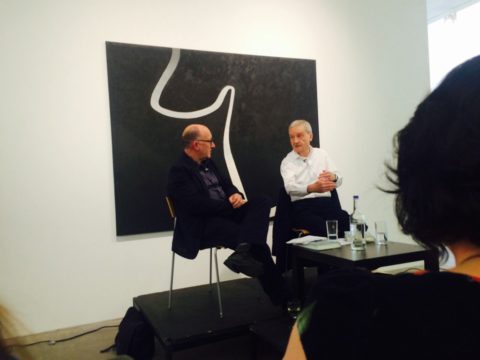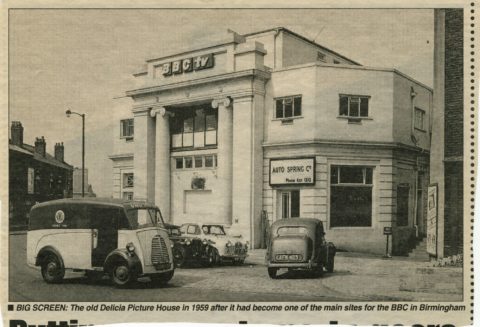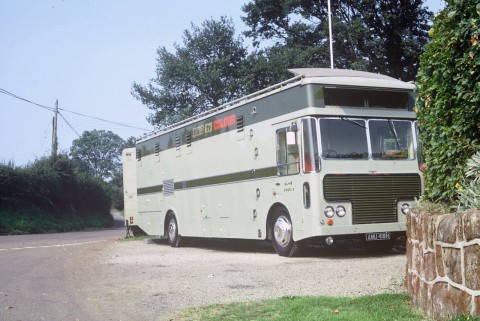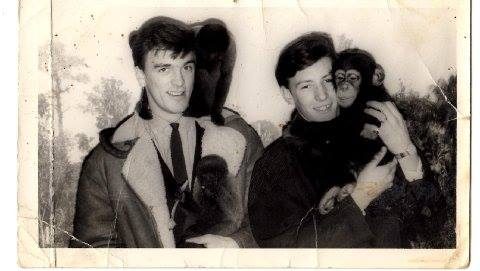
Roger Shannon and Tony Garnett in conversation. Copyright Flatpack.
Last night I went to Tony Garnett’s book signing event at the Ikon Gallery, Birmingham. Tony was in conversation with Roger Shannon, and when asked why he wrote his memoirs, The Day the Music Died, he said, because he had to. He described it as a very painful process, where sometimes he had to stop writing because he couldn’t see the page through his tears! Tony certainly seemed to have experienced more than his fair share of tragedy, especially early in his childhood, when he lost his mother. He told the audience that until he wrote the book, that he hadn’t realised how much his childhood experiences had shaped his approach to the dramas he later produced. Tony was born in 1936, in Erdington and remembered the war in Birmingham well. He was brought up in a large family, with many uncles and aunts, and lots of cousins. He began his working life as an actor, and had a promising career, appearing in a number of stage and television plays. One television play he acted in was The Alchemist, produced by Peter Dews, which was a live drama from Gosta Green, BBC’s Birmingham drama studios before Pebble Mill was built. Also appearing in this production was Topsy Jane, who Tony described as the love of his life, who sadly later suffered from mental health issues.
Here is the Radio Times entry for The Alchemist, by Ben Jonson, transmitted on 29th May 1961, at 21.20. You’ll notice Tony’s credit towards the bottom of the list, playing ‘Kastril, the Angry Boy’:
http://genome.ch.bbc.co.uk/90d4bd2d1ff14e8b8724dc8bbfe8419b
“starring
AI.AN DOBIE
PATSY ROWLANDS
JOHN WARNER
Produced by Peter Dews
Neighbours, Officers:
Colin Campbell , Mary Chester
Roser Croueher , Murray Gilmore Timothy Harley , Loelia Kidd
Henry Manning , Monica Stewart Isobel Swan
Face and his confederates, Subtle and Doll Common, get up to every trick, squeezing money out of the gullible and the greedy. These lead to outrageous complications which resolve only as the play ends.
Designer, Charles Carroll From the Midlands
See page 21
Contributors
Unknown: Patsy Rowlands
Unknown: John Warner
Produced By: Peter Dews
Unknown: Colin Campbell
Unknown: Mary Chester
Unknown: Roser Croueher
Unknown: Murray Gilmore
Unknown: Timothy Harley
Unknown: Loelia Kidd
Unknown: Henry Manning
Unknown: Monica Stewart
Unknown: Isobel Swan
Designer: Charles Carroll
Face, the Housekeeper: Alan Dobie
Subtile the Alchemist: John Warner
DoH Common, their Colleague: Patsy Rowlands
Lovewit Master of the House: William Mervyn
Dapper, a Lawyer’s Clerk: Edward Petherbridge
Abel Drugger, A Tobacco Man: Terry Scully
Sir Epicure Mammon, a Knight: Thomas Gallagher
Pertinax Surly, a Gamester: Jerome Willis
Ananias, a Deacon: David William
TribulationWholesome, a Pastor: Peter Duguid
Kastril, the Angry Boy: Tony Garnett
Dame Plianthis Sister, a Widow: Topsy Jane”
Unfortunately this production seems to have been Tony’s only work for BBC Birmingham, although he was friendly with David Rose, so it was a little surprising that he never produced any of the English Regions Drama Department plays from Pebble Mill.

Tony Garnett in The Alchemist, copyright resides with the original holder, no reproduction without permission. Thanks to Joyce Hawkins for sharing the photo.
Save
Save
Save
Save
Save
Save





